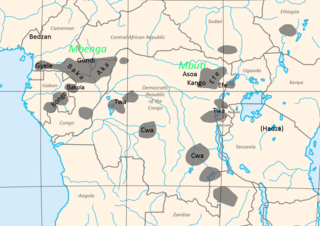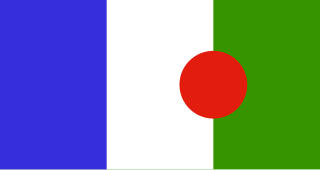Related Research Articles

In anthropology, pygmy peoples are ethnic groups whose average height is unusually short. The term pygmyism is used to describe the phenotype of endemic short stature for populations in which adult men are on average less than 150 cm tall.

The Mbuti people, or Bambuti, are one of several indigenous pygmy groups in the Congo region of Africa. Their languages are Central Sudanic languages and Bantu languages.

The Aka or Bayaka are a nomadic Mbenga pygmy people. They live in southwestern Central African Republic and in northern Republic of the Congo. They are related to the Baka people of Cameroon, Gabon, northern Congo, and southwestern Central African Republic.

The Baka people, known in the Congo as Bayaka, are an ethnic group inhabiting the southeastern rain forests of Cameroon, northern Republic of the Congo, northern Gabon, and southwestern Central African Republic. They are sometimes called a subgroup of the Twa, but the two peoples are not closely related. Likewise, the name "Baka" is sometimes mistakenly applied to other peoples of the area who, like the Baka and Twa, have been historically called pygmies, a term that is now considered derogatory.
The Efé are a group of part-time hunter-gatherer people living in the Ituri Rainforest of the Democratic Republic of Congo. In the depths of the forest they do not wear much clothing, using only leaf huts as shelter for their bodies in the intense heat. The Efé are Pygmies, and one of the shortest peoples in the world. The men grow to an average height of 142 cm, and women tend to be about 5 cm shorter.
The Mambilla or Mambila people of Nigeria live on the Mambilla Plateau. A small fraction of Mambilla migrants left the Mambilla Plateau for the Ndom Plain on the Cameroon side of the international border as well as in a couple of small villages, such as New Namba, on the Gashaka Plain in the north, and Jiini-Nyalang-Langa area close to the Kwanja. Today, the preferred ethnonym is spelt Mambila in Cameroon and Mambilla in Nigeria. "Norr" is also used.
The Bongo people, also called Babongo or Bazimba, are an agricultural people of Gabon in equatorial Africa who are known as "forest people" due to their recent foraging economy.

Aweer (Aweera), also known as Boni, is a Cushitic language of Eastern Kenya. The Aweer people, known by the arguably derogatory exonym "Boni," are historically a hunter-gatherer people, traditionally subsisting on hunting, gathering, and collecting honey. Their ancestral lands range along the Kenyan coast from the Lamu and Ijara Districts into Southern Somalia's Badaade District.
Lese is a Central Sudanic language of northeastern Congo-Kinshasa, as well as a name for the people who speak this language. The Lese people, live in association with the Efé Pygmies and share their language, which is occasionally known as Lissi or Efe.

The Kwasio language, also known as Ngumba / Mvumbo, Bujeba, and Gyele / Kola, is a language of Cameroon, spoken in the south along the coast and at the border with Equatorial Guinea by some 70,000 members of the Ngumba, Kwasio, Gyele and Mabi peoples. Many authors view Kwasio and the Gyele/Kola language as distinct. In the Ethnologue, the languages therefore receive different codes: Kwasio has the ISO 639-3 code nmg, while Gyele has the code gyi. The Kwasio, Ngumba, and Mabi are village farmers; the Gyele are nomadic Pygmy hunter-gatherers living in the rain forest.
Bila, or Forest Bira, is a Bantu language spoken in the Mambasa Territory of the Democratic Republic of Congo. It is also spoken by the Mbuti Pygmies who live in that area. Pygmy groups to the west include the Kango and Sua (Batchua). Other Mbuti speak Central Sudanic languages. The Kango and Sua speak distinct dialects, but not enough to impair mutual intelligibility with their farming Bila patrons.
Tikar is a Northern Bantoid, semi-Bantu language spoken in Cameroon by the Tikar people, as well as by the Bedzan Pygmies, who speak a dialect of the language. According to linguist and anthropologist Harry H. Johnston, Semi-bantu and Bantu syntax suggests influence from mixed dynastic Egyptians and the "Negro languages in western and central Sudan."
The Kango (Bakango), also known as the Batchua and Mbuti-Sua, are an Mbuti pygmy people of the Ituri forest. They speak a Bantu language, Bila, apparently in two dialects, northern Sua and southern Kango.

The Congo Pygmies are those "forest people" who have, or recently had, a hunter-gatherer economy and a simple, non-hierarchical societal structure based on bands, are of short stature, have a deep cultural and religious affinity with the Congo forest and live in a generally subservient relationship with agricultural "patrons", with which they trade forest products such as meat and honey for agricultural and iron products.

The Twa are a group of indigenous African Pygmy tribes.

The 14,000 Twa of the swamp forest north and west of Lake Tumba and between Tumba and Lake Mai-Ndombe in the west of the Congo are one of several fishing and hunter-gatherer castes living in a patron–client relationship with farming Bantu peoples across central and southern Africa. In this case the people are the Mongo, specifically the Mongo tribes known as Ntomba, Lia (Bolia), and Konda. The two castes are called Oto and Twa: The Oto are the agricultural patrons of the Twa.
The Kwisi are a seashore-fishing and hunter-gatherer people of southwest Angola that physically seem to be a remnant of an indigenous population—along with the Kwadi, the Cimba, and the Damara—that are unlike either the San (Bushmen) or the Bantu. Culturally they have been strongly influenced by the Kuvale, and speak the Kuvale dialect of Herero. There may, however, have been a few elderly speakers of an unattested Kwisi language in the 1960s.

The Great Lakes Twa, also known as Batwa, Abatwa or Ge-Sera, are a Bantu ethnic group native to the African Great Lakes region on the border of Central and East Africa. As an indigenous pygmy people, the Twa are generally assumed to be the oldest surviving population of the Great Lakes region. Current populations of Great Lakes Twa people live in the states of Rwanda, Burundi, Uganda and the eastern portion of the Democratic Republic of Congo. In 2000 they numbered approximately 80,000 people, making them a significant minority group in these countries.

The African Pygmies are a group of ethnicities native to Central Africa, mostly the Congo Basin, traditionally subsisting on a forager and hunter-gatherer lifestyle. They are divided into three roughly geographic groups:
West African hunter-gatherers, West African foragers, or West African Pygmies dwelled in western Central Africa earlier than 32,000 BP and dwelled in West Africa between 16,000 BP and 12,000 BP until as late as 1000 BP or some period of time after 1500 CE. Despite its significance in the prehistory of West Africa, the populating of various parts of Western Africa from the Sub-Saharan regions of coastal West Africa and the forests of western Central Africa often goes overlooked.
References
- ↑ Hewlett & Fancher (2011) "Central African Hunter-Gatherer Research Traditions". In Cummings, Jordan, & Zvelebil, eds, Oxford Handbook of the Archaeology and Anthropology of Hunter-Gatherers.
- ↑ Barbier, J.-C. (1978) Les pygmées de la plaine Tikar au Cameroun. Yaoundé.
- ↑ "Bedzan Pygmies". Pygmies.org. Retrieved 2022-05-15.
- ↑ Bedzan Pygmies From The Tikar Plain, CD, 2000.